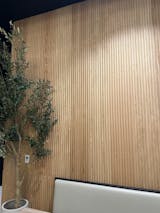10 Sustainable Interior Design Ideas for a Green Home Makeover

Ever feel like your home could use a makeover, but you're also worried about the impact on the planet? Sustainability is becoming a bigger part of our lives, from the food we eat to the cars we drive. Now, it's even making its way into our homes through sustainable interior design.
What exactly is sustainable interior design? In simple terms, it’s about creating spaces that are kind to the environment. This means using eco-friendly materials, reducing waste, and making energy-efficient choices.
It’s not just about looking good — it’s about feeling good too, knowing your home is doing its part for the environment.
In this blog, we’ll take a look at ten sustainable interior design ideas that can transform your home into a green haven. We’ll also explore some of the surprising benefits sustainable interior design has to offer.
10 sustainable interior design ideas for your home
Whether you're doing a total remodel or just looking to make a few eco-friendly upgrades, there are countless ways to make your space more sustainable. Here are our top ten suggestions.
1. Use responsibly sourced wood
One of the best ways to green up your home is by using sustainable interior design materials, such as reclaimed wood. This usually involves repurposing wood from old buildings, barns, or even shipping pallets.
Not only does this give the wood a second life, but it also means less demand for new timber. The less timber we need, the fewer trees we have to cut down.
Responsibly sourced wood can be used in a variety of ways. For furniture, think dining tables, coffee tables, and bookshelves. For flooring, reclaimed wood adds a rustic charm that’s hard to mimic with new materials. You can even use it for wood-slat accent walls, kitchen countertops, or headboards.
Wondering where to find reclaimed wood? Many specialty stores and online marketplaces offer it, or you can even check local salvage yards.
2. Shop with climate-conscious brands
The brands you buy from can make a big difference in sustainable interior design. The products they sell, how they make and ship them, and their impact on the environment all matter.
Choosing climate-conscious companies can reduce your projects’ impact on the planet.
What does it mean for a brand to be eco-friendly? These organizations often use sustainable materials, ethical production methods, and sustainable packaging. Many also give back to the environment, making your purchases even more meaningful.
For example, at Andor Willow, we uphold our commitment to sustainability by planting one tree for every Willow Panel sold. By the end of 2024, our goal is to have planted 30,000 trees across North America. This not only helps reduce our carbon footprint but it supports reforestation effort.

3. Choose low-VOC paints
VOCs — or Volatile Organic Compounds — are chemicals that evaporate into the air and can cause various health issues, from headaches to respiratory problems. They’re commonly found in traditional paints, which can release harmful fumes long after the last coat has dried.
This not only affects indoor air quality but also contributes to environmental pollution.
Fortunately, there are eco-friendly alternatives: low-VOC and zero-VOC paints. These contain fewer or no harmful chemicals, making them a healthier choice for your home and the planet. Plus, they’re just as effective and come in a wide range of colors.
4. Incorporate natural textiles

Choosing natural textiles like organic cotton, linen, and wool is another great sustainable interior design option. Comfortable and stylish, these materials are much better for the environment compared to synthetic options (such as polyester, nylon, and rayon).
For example, organic cotton is grown without harmful pesticides, which protects the earth’s soil and water. Linen, made from flax plants, doesn’t need as much water or energy during production as synthetic fabrics. Wool is renewable, durable, and naturally resistant to dust mites and mold.
You can use natural textiles in various areas of your home. For instance, linen curtains add a light, airy feel to any room while keeping it eco-friendly. Bedding made from organic cotton or wool ensures a healthier sleeping environment free from harsh chemicals.
Plus, because all these materials come in various colors and patterns, you can style your space to your taste while protecting the planet. It’s a simple yet effective way to embrace sustainable interior design.
5. Choose energy-efficient lighting
Sometimes, making your home a greener place is as simple as swapping out your light bulbs. LED (Light Emitting Diode) and CFL (Compact Fluorescent Lamp) bulbs are much better for the environment than traditional incandescent bulbs. They use less energy, last longer, and reduce the overall carbon footprint of your home.
LED bulbs use at least 75% less energy and last up to 25 times longer than incandescent lighting. CFL bulbs also offer significant energy savings and have a longer lifespan than traditional bulbs, though not as long as LEDs.
Even better, you can use the most energy-efficient light source of all: the sun. Maximizing natural light is a fantastic way to save energy. Use sheer curtains to let in more daylight and place mirrors strategically around your home to reflect natural light.
6. Use recycled materials

By using recycled materials, there’s less of a need to harvest new raw materials. This in turn lowers greenhouse gas emissions and conserves energy — both of which are amazing for the environment.
Examples of recycled materials could include glass, metal, and certain plastics. Recycled glass can be used for countertops, tiles, and decorative pieces. Metal, such as aluminum and steel, can be used for fixtures and furniture. Some plastics, when recycled properly, can be transformed into flooring, rugs, and outdoor furniture.
A great example is Andor Willow’s felt panel backing, which comes with every purchase of our wall panels (be it our wood slat wall panels or our paintable wall panels). The felt — which holds the wall slats permanently in place — is made from recycled water bottles and is 100% recyclable.
7. Install bamboo flooring
Bamboo flooring is a fantastic sustainable alternative to traditional hardwood. Unlike hardwood trees, which can take decades to mature, bamboo grows incredibly quickly — some species can grow nearly three feet in a single day! This rapid growth makes bamboo a highly renewable resource.
Best of all, bamboo isn’t just eco-friendly — it’s also durable and beautiful.
Bamboo flooring is tough and can withstand heavy foot traffic, making it an excellent choice for high-traffic areas like living rooms, hallways, and kitchens. Bamboo also has a natural yet elegant look. With a range of finishes available — from light and airy to dark and sophisticated —there’s something to suit the aesthetic of any home.
8. Upcycle old furniture

Upcycling is essentially giving old or discarded items a second life. In doing so, you divert these objects from landfills and reduce the need for new materials.
There are countless DIY upcycling projects you can try at home. For example, you can turn an old dresser into a stylish bathroom vanity by adding a fresh coat of paint and a sink. An outdated coffee table can be refreshed with a new stain, or you could repurpose it entirely by adding a cushion and turning it into a chic bench.
9. Install water-efficient fixtures
Water is one of our planet’s most precious resources, so it’s important to conserve it. Installing water-efficient fixtures is a small upgrade that can make a big impact. These fixtures are designed to use less water without sacrificing performance or appearance.
Low-flow showerheads and faucets are great options that limit water flow while maintaining strong pressure. So, you can use less water while still enjoying satisfying showers and washing your hands with ease. Dual-flush toilets are another great solution. These toilets have two buttons: one for a low-water volume flush and one for a high-water volume flush. Using these can save gallons of water every single day.
10. Add some greenery

If you thought indoor plants were just for decoration, think again; they also have a huge impact on sustainability. Indoor plants improve air quality, remove toxins, and increase oxygen levels, making your home a healthier, more eco-friendly place.
We recommend varieties like snake plants, spider plants, and peace lilies. These plants are easy to care for and filter harmful substances from the air.
There are plenty of ways to add a splash of greenery to your home. Don’t have a lot of free floor space? Use hanging planters or place potted plants on shelves and tables. You can also style plants based on your unique aesthetic. For a modern look, use sleek, minimalist pots. Or, if you’re into a more rustic or bohemian feel, woven baskets might be a better fit.
Adding greenery is a simple, effective way to embrace sustainable interior design while making your home more beautiful.
The benefits of sustainable interior design
While the main perk of sustainable interior design is helping the environment, there are many other ways it can benefit you.
Improving your health
Sustainable interior design can do wonders for your health. Consider air quality as an example.
Research shows that exposure to air pollution can have a huge impact on your health. When we breathe in air pollutants, this can lead to coughing, itchy eyes, and/or breathing difficulties.
Simple things like choosing low-VOC paints, opting for natural textiles, and adding indoor plants can improve indoor air quality and reduce exposure to harmful chemicals.

Less pressure on your wallet
While some sustainable items may cost more upfront, they often save you money in the long run.
For example, energy-efficient lighting and water-saving fixtures can greatly reduce utility bills. These kinds of savings add up over time, making sustainable choices financially smart.
Boosting your home’s appeal
A well-designed, eco-friendly home can increase property value and appeal to environmentally-conscious buyers. A 2021 report from the National Association of Home Builders (NAHB) found that several energy-efficient features were listed as must-haves among home buyers. Some of these included:
- Energy Star-rated windows
- Energy Star-rated appliances
- Energy-efficient lighting
- Triple-pane insulating glass windows
Eco-friendly homes are often listed at higher prices and sell faster than conventional homes. According to a 2022 Zillow analysis, homes with climate-conscious features (e.g. electric vehicle charging stations, drought-resistant landscaping or turf, etc.) often sold nine to 10 days faster than similar homes without these features.
A brighter, greener future starts at home
Starting your green home makeover can feel overwhelming. But remember: you don't need to overhaul everything at once.
Whether it's switching to energy-efficient lighting, using reclaimed wood, or grabbing a few indoor plants, every small change makes a difference. Over time, these little steps add up to create a bigger, longer-lasting effect on the environment.




































“This article gives excellent insights into the rapid growth of Hyderabad’s real estate sector. At ForestNation, we’ve seen rising demand for eco-friendly gated villas that combine modern amenities with sustainable living. Projects like ours in Sadhnagar are aligning perfectly with these investment trends. Thanks for sharing such valuable data!”
Loved the practical and stylish tips! This blog beautifully blends sustainability with design, truly inspiring for anyone looking to create an eco-friendly home.
A beautifully written guide! These sustainable interior design ideas are practical, inspiring, and essential for anyone planning a green home makeover.
The idea of using sustainable materials, like reclaimed wood, to create stylish, green spaces is fantastic.
Loved these sustainable interior design ideas! A great way to create an eco-friendly and stylish home. Thanks for sharing!
Leave a comment